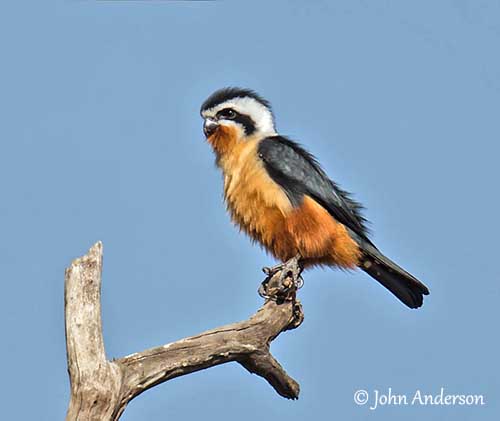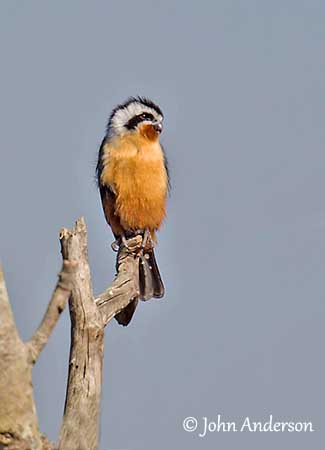
Fr: Fauconnet à collier
Ang: Colared falconet
All: Rotkehlfälkchen
Esp: Falconete Acollarado
Ita: Falconetto dal collare
Nd: Roodbroekdwergvalk
Sd: halsbandspygméfalk
Photographer:
John Anderson
John Anderson Photo Galleries
Text by Nicole Bouglouan
Sources :
HANDBOOK OF THE BIRDS OF THE WORLD Vol 2 by Josep del Hoyo-Andrew Elliot-Jordi Sargatal - Lynx Edicions - ISBN: 8487334156
A Field Guide to the Birds of South-East Asia by Craig Robson. New Holland Publishers. ISBN: 9781780090498
A photographic guide to Birds of Vietnam, Cambodia and Laos by Peter Davidson. New Holland Publishers. ISBN: 9781847731418
BirdLife International (BirdLife International)
Global Raptor Information Network - Working to Conserve Birds of Prey in nature
Wikipedia, the free encyclopaedia
Notes on the population density and feeding ecology of the Collared Falconet
Microhierax caerulescens in Buxa Tiger Reserve, West Bengal, India
S. SIVAKUMAR, HILLALJYOTI SINGHA and VIBHU PRAKASH
Collared Falconet
Microhierax caerulescens
Falconiformes Order – Falconidae Family
INTRODUCTION:
The genus Microhierax includes the smallest of all birds of prey. The Collared Falconet can measure 15-18 centimetres in total length. It feeds mainly on large insects often caught in the air in shrike-like attack flight. However, in spite of its small size, it also takes some lizards and small mammals. It roosts and nests in cavities, usually abandoned by other bird species.
Cooperative breeding is reported for the subspecies “burmanicus”, but usually, the Collared Falconet is often seen alone or in pairs, and in small groups too, perched on dead branches for long periods.
DESCRIPTION OF THE BIRD:
Biometrics:
Length: 14-18 cm
Wingspan: 28-34 cm
Weight: 30-50 g
The adult has glossy black upperparts with some white markings on innermost secondaries and tail quills. On the underparts, throat, lower belly and thighs are rufous, whereas breast and upper belly are variable, from whitish to chestnut. The underwing-coverts are white. Flight feathers and rectrices are barred black and white.
On the head, crown, nape and ear-covert patch are black. Forehead, eyebrow and malar stripe are white. We can see a conspicuous white collar.
The “toothed” bill is blackish with pale grey cere. The eyes are dark brown, surrounded by pale grey eyering. Legs and feet are dark grey to blackish.

The female is slightly larger than male. She has more white on the wings, and less prominent nuchal collar.
The juvenile has rufous forehead and eyebrow, and white throat (some adult females may share these features). The bill is yellowish.
SUBSPECIES AND RANGE:
The Collared Falconet has currently two recognized subspecies.
M.c. caerulescens (described above and displayed) occurs in E Himalayas to NE India.
M.c. burmanicus is found in Myanmar E to C & S Indochina.
This race is slightly smaller than nominate. The breast is whiter and the nuchal collar is wider.
HABITAT:
The Collared Falconet frequents deciduous forest, edges and clearings in broadleaved evergreen and mixed forests, old cultivations with dead trees and natural open areas. It can be seen near rivers and streams, and it occurs from sea-level up to 1800-2300 metres of elevation according to the range.
CALLS AND SONGS: SOUNDS BY XENO-CANTO
The Collared Falconet gives high-pitched “kli-kli-kli” or “killi-killi-killi”. Both mates duet, uttering long series of peeping whistles “pseep-pseep…” rising and falling both in pitch and volume.
BEHAVIOUR IN THE WILD:
The Collared Falconet hunts from perch, searching actively from preys by turning the head rapidly. It performs several foraging sallies, and the preys are usually caught up to 50 metres from the perch. However, insects are often caught in the air.
The preys include large insects such as butterflies, dragonflies, grasshoppers, beetles and cicadas, but it also takes small birds, lizards and small mammals.
It forages by short flights from perches, often dead branches, and returns to the perch to eat the prey. It hunts like a flycatcher or a small shrike rather than a falcon.
The birds can be taken on the ground in open areas, but also after rapid aerial pursuits. From an observation, only birds are brought to the nest for feeding the chicks.
The Collared Falconet may sometimes hunt in small groups of 1-7 individuals, but usually close to the nightime roosts. It is often more active at dusk when it can catch moths.

During the breeding season, the Collared Falconet performs some displays, especially mutual preening. Aerial displays are not reported.
It nests in holes abandoned by woodpeckers and barbets. The adults may become aggressive in nest defence.
The race “burmanicus” performs cooperative breeding, with several adults rearing the chicks.
The Collared Falconet is sedentary in its range, but some altitudinal movements are reported in winter.
The flight is direct and fast, with rapid wingbeats interspersed with long glides.
REPRODUCTION OF THIS SPECIES:
The breeding season takes place between February-March and May. Displays and pair formation start in March.
The Collared Falconet uses a hole made by a woodpecker or a barbet, usually placed between 7 and 12 metres above the ground. It may occasionally use hollows in buildings or natural holes in trees. The hole is half-filled with a layer of dried leaves and insect parts.
The female lays 4-5 dirty white eggs that often become stained or spotted reddish towards the end of the incubation. Both adults incubate but the female performs longer periods. The chicks are fed by both parents. The adults are very aggressive towards intruders, both humans and animals, if they approach the nest-site.
PROTECTION / THREATS / STATUS:
The Collared Falconet has wide range in which it is relatively common. The species can adapt to disturbed habitats and varied diet.
The population has not been quantified, but it is estimated to number in the tens of thousands. It is suspected to be stable.
The Collared Falconet is currently evaluated as Least Concern.